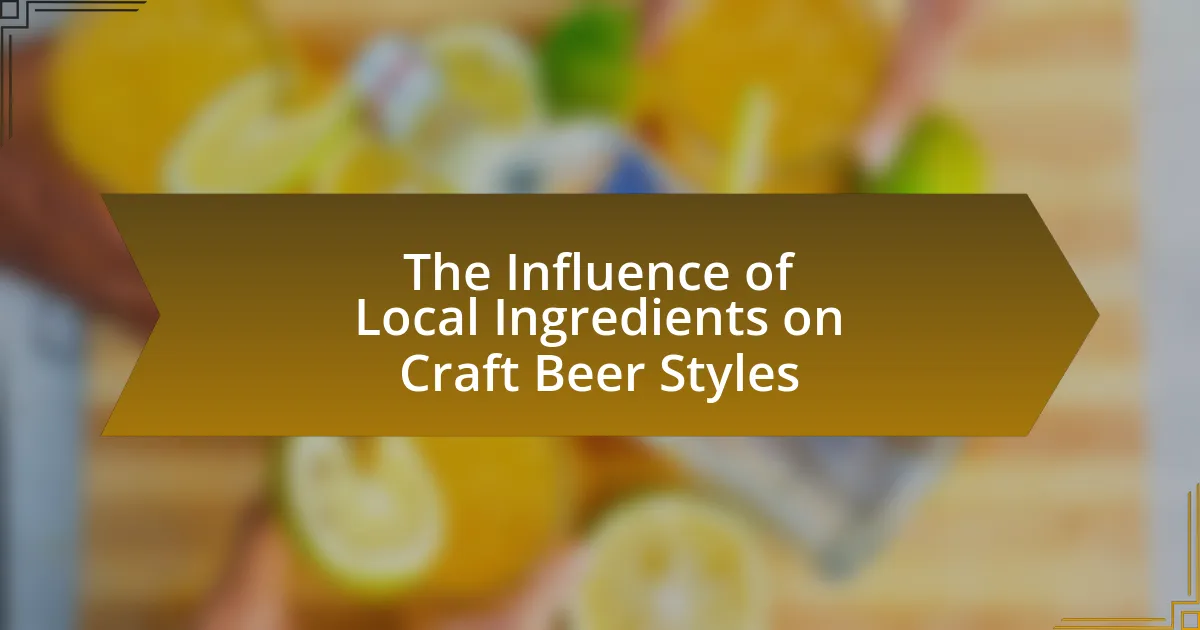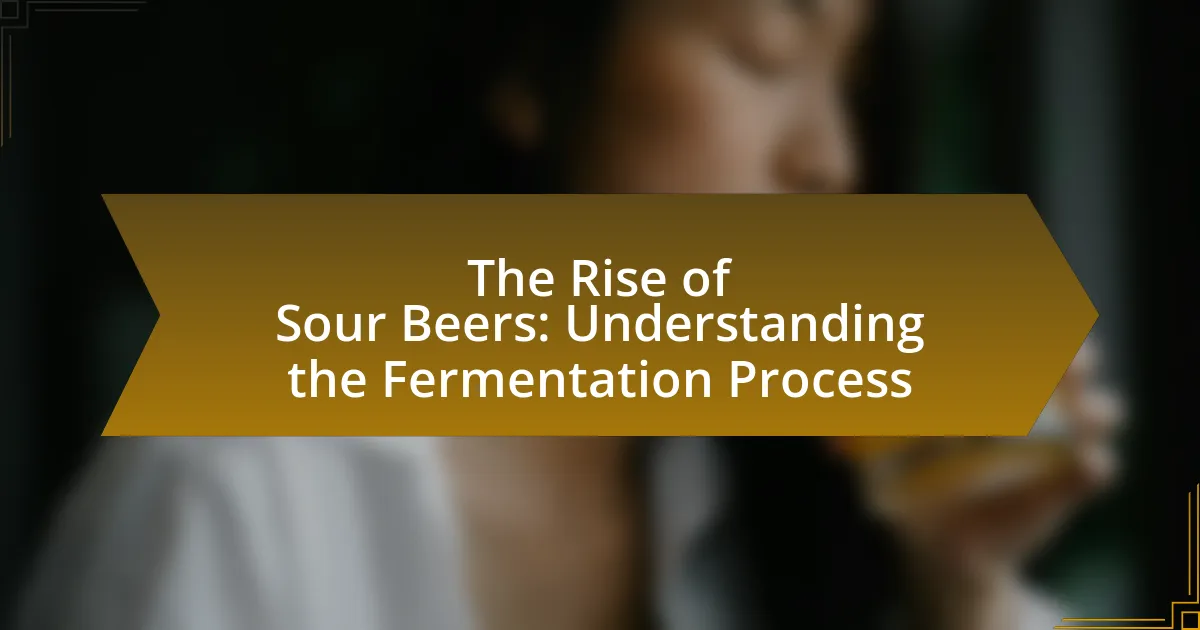Amber Ales are a distinct style of beer known for their amber to copper color, balanced malt sweetness, and moderate hop bitterness. This article explores the defining characteristics of Amber Ales, including their flavor profiles, common ingredients, and brewing processes. It also highlights the differences between various Amber Ale styles, such as American and English Amber Ales, and discusses suitable food pairings that enhance the overall tasting experience. Additionally, the article provides insights into the ideal serving temperature and tips for appreciating the flavors of Amber Ales.

What are Amber Ales?
Amber ales are a style of beer characterized by their amber to copper color, which results from the use of caramel malts. These ales typically feature a balanced flavor profile, combining malt sweetness with moderate hop bitterness. The malt backbone often includes notes of toffee, caramel, and biscuit, while the hop presence can range from floral to citrusy, depending on the specific recipe. Amber ales are known for their medium body and smooth mouthfeel, making them approachable for a wide range of beer drinkers.
How are Amber Ales different from other beer styles?
Amber Ales are distinct from other beer styles primarily due to their balanced malt and hop profile, which results in a moderate sweetness and a rich amber color. This style typically features caramel and toasty malt flavors, achieved through the use of crystal malts, while maintaining a moderate hop bitterness that does not overpower the malt character. The alcohol content usually ranges from 4.5% to 6.5%, placing Amber Ales in a versatile category that appeals to a wide range of beer drinkers. Additionally, the use of American hops can impart citrus and pine notes, further differentiating them from lighter lagers or darker stouts, which may emphasize either malt or hop characteristics more heavily.
What are the defining characteristics of Amber Ales?
Amber Ales are characterized by their medium to medium-dark amber color, balanced malt sweetness, and moderate hop bitterness. These ales typically feature caramel and toasty malt flavors, which contribute to their rich, smooth mouthfeel. The alcohol content usually ranges from 4.5% to 6.5%, making them approachable for a wide audience. Additionally, Amber Ales often exhibit a slight fruity estery aroma, enhancing their overall complexity. The balance between malt and hops is a defining trait, ensuring that neither flavor dominates, which is a hallmark of this style.
What flavors and aromas can be expected from Amber Ales?
Amber Ales typically exhibit flavors and aromas of caramel, toffee, and toasted malt, complemented by a moderate hop presence. The malt-forward profile often includes notes of biscuit and nut, while the hop character can introduce floral or citrus undertones. This combination creates a balanced and rich sensory experience, characteristic of the style.
What ingredients are commonly used in Amber Ales?
Amber Ales commonly use pale malt, crystal malt, and a variety of hops. Pale malt serves as the base, providing the primary fermentable sugars, while crystal malt contributes to the beer’s caramel flavor and amber color. Hops, such as Cascade or Centennial, are often added for bitterness and aroma, balancing the sweetness from the malts. This combination results in a well-rounded flavor profile typical of Amber Ales.
How do different malts influence the taste of Amber Ales?
Different malts significantly influence the taste of Amber Ales by contributing various flavors, aromas, and colors. Base malts, such as Pale Malt, provide a foundation of sweetness and body, while specialty malts like Crystal or Caramel Malt add notes of caramel, toffee, and a rich mouthfeel. Additionally, darker malts, such as Munich or Chocolate Malt, can introduce flavors of chocolate, coffee, or toasted bread, enhancing complexity. The balance of these malts determines the overall profile of the ale, with a typical Amber Ale showcasing a harmonious blend of malt sweetness and moderate bitterness, often resulting in a well-rounded and flavorful beer.
What role do hops play in the flavor profile of Amber Ales?
Hops contribute bitterness, aroma, and flavor complexity to the profile of Amber Ales. The bitterness from hops balances the malt sweetness characteristic of Amber Ales, preventing the beer from being overly sweet. Additionally, the specific hop varieties used can impart floral, citrus, or pine notes, enhancing the overall flavor experience. For instance, varieties like Cascade or Centennial are often employed to provide a balanced yet pronounced hop character, which is essential in defining the style. This interplay between malt and hops is crucial, as it creates a harmonious flavor profile that is both rich and refreshing.

How are Amber Ales brewed?
Amber Ales are brewed through a process that involves mashing malted barley, boiling the wort, fermenting with yeast, and conditioning the beer. The brewing begins with the mashing of pale malt and specialty malts, which contribute to the amber color and flavor profile. The wort is then boiled, typically with hops added for bitterness and aroma. After boiling, the wort is cooled and yeast is introduced for fermentation, usually lasting one to two weeks. Finally, the beer is conditioned to develop its flavors before packaging. This method results in a balanced ale with a rich malt character and moderate hop presence, characteristic of Amber Ales.
What is the brewing process for Amber Ales?
The brewing process for Amber Ales involves several key steps: mashing, boiling, fermenting, conditioning, and packaging. Initially, malted grains, primarily pale and caramel malts, are mashed with hot water to convert starches into fermentable sugars. This mixture is then boiled, during which hops are added for bitterness and aroma. After boiling, the wort is cooled and yeast is introduced for fermentation, typically lasting one to two weeks. Following fermentation, the beer undergoes conditioning to develop its flavors before being packaged for distribution. This process results in the balanced malt sweetness and hop character characteristic of Amber Ales.
What steps are involved in mashing and boiling for Amber Ales?
The steps involved in mashing and boiling for Amber Ales include mashing the grains at a specific temperature, typically around 150-155°F (65-68°C), for about 60 minutes to convert starches into fermentable sugars. Following mashing, the wort is separated from the grains and then boiled, usually for 60-90 minutes, during which hops are added at various stages for bitterness, flavor, and aroma. This process is essential for developing the characteristic malt profile and color of Amber Ales, as the combination of specific grains and hop additions directly influences the final taste and quality of the beer.
How does fermentation affect the final product of Amber Ales?
Fermentation significantly influences the final product of Amber Ales by determining the flavor profile, aroma, and mouthfeel. During fermentation, yeast converts sugars into alcohol and carbon dioxide, which contributes to the beer’s overall taste and character. For Amber Ales, the fermentation process often emphasizes malt-forward flavors, resulting in a balanced sweetness complemented by subtle hop bitterness. Additionally, the choice of yeast strain can introduce esters and phenols, enhancing fruity or spicy notes that further define the beer’s complexity. Studies show that fermentation temperature and duration also play crucial roles in developing these characteristics, with higher temperatures often leading to more pronounced fruity flavors.
What are the common variations of Amber Ales?
Common variations of Amber Ales include American Amber Ale, English Amber Ale, and Belgian Amber Ale. American Amber Ales typically feature a balance of malt sweetness and hop bitterness, often with a citrus or pine aroma due to the use of American hops. English Amber Ales are characterized by their malt-forward profile, showcasing caramel and toasty flavors with a more subdued hop presence. Belgian Amber Ales incorporate Belgian yeast, adding fruity and spicy notes to the malt backbone, resulting in a complex flavor profile. These variations highlight the diverse interpretations of Amber Ales across different brewing traditions.
What distinguishes American Amber Ales from English Amber Ales?
American Amber Ales are distinguished from English Amber Ales primarily by their hop-forward flavor profile and higher alcohol content. While both styles share a malt backbone, American Amber Ales typically feature a more pronounced hop bitterness and aroma, often utilizing American hop varieties that impart citrus and pine notes. In contrast, English Amber Ales tend to emphasize malt sweetness and caramel flavors, with a more subdued hop presence, reflecting traditional English brewing practices. This difference in hop usage and flavor balance is a key characteristic that sets the two styles apart.
How do Amber Ales differ in flavor and style across regions?
Amber Ales differ in flavor and style across regions primarily due to variations in local ingredients, brewing techniques, and cultural preferences. For instance, American Amber Ales often feature a pronounced hop character with citrus and pine notes, attributed to the use of American hop varieties, while British Amber Ales tend to emphasize malt sweetness and caramel flavors, reflecting the use of traditional British malts. Additionally, regional water profiles can influence the final taste; for example, softer water in England enhances malt flavors, whereas harder water in the U.S. can accentuate hop bitterness. These regional distinctions are supported by the Beer Judge Certification Program guidelines, which categorize Amber Ales based on these flavor profiles and brewing traditions.

What food pairings complement Amber Ales?
Amber Ales pair well with a variety of foods, including roasted meats, grilled vegetables, and rich cheeses. The malt-forward profile of Amber Ales complements the caramelized flavors of roasted meats, while the moderate hop bitterness balances the richness of dishes like barbecue. Additionally, the sweetness of Amber Ales enhances the flavors of aged cheeses, making them an excellent match. Studies in beer and food pairing suggest that the caramel and toasty notes in Amber Ales create a harmonious experience with these food choices, reinforcing their compatibility.
How can Amber Ales enhance a meal?
Amber Ales can enhance a meal by complementing and balancing flavors due to their malt-forward profile and moderate hop bitterness. The caramel and toasty notes in Amber Ales pair well with rich foods like roasted meats and grilled vegetables, while their slight sweetness can offset spicy dishes. Studies show that beer, including Amber Ales, can enhance the perception of flavors in food, making the overall dining experience more enjoyable. For instance, a 2018 study published in the Journal of Culinary Science & Technology found that pairing specific beer styles with food can elevate taste satisfaction and flavor harmony.
What types of dishes pair well with Amber Ales?
Amber Ales pair well with a variety of dishes, particularly those that feature roasted or grilled meats, such as barbecue chicken, burgers, and steak. The malt-forward profile of Amber Ales complements the caramelized flavors in these dishes, enhancing the overall dining experience. Additionally, Amber Ales also pair nicely with hearty vegetarian options like roasted vegetables and grain-based salads, as the beer’s moderate bitterness balances the richness of these meals. This pairing is supported by the beer’s flavor profile, which typically includes caramel, toffee, and a hint of hop bitterness, making it versatile for both meat and vegetable dishes.
How does the sweetness of Amber Ales interact with food flavors?
The sweetness of Amber Ales enhances food flavors by providing a balancing contrast to savory and spicy dishes. This sweetness can complement rich foods like roasted meats and barbecued items, as well as desserts, creating a harmonious pairing. For example, the caramel and toasty malt notes in Amber Ales can elevate the flavors of grilled meats, while their sweetness can soften the heat in spicy cuisines, making the overall dining experience more enjoyable.
What are some tips for enjoying Amber Ales?
To enjoy Amber Ales, serve them slightly chilled, ideally between 45°F to 55°F, to enhance their malt flavors and aromas. This temperature range allows the caramel and toasty notes to shine while balancing the hop bitterness. Additionally, use a tulip or pint glass to concentrate the aromas, which enhances the overall tasting experience. Pair Amber Ales with foods like grilled meats, roasted vegetables, or spicy dishes, as their malt sweetness complements these flavors well. Studies show that food pairing can elevate the tasting experience by creating a harmonious balance between the beer and the meal.
What serving temperature is ideal for Amber Ales?
The ideal serving temperature for Amber Ales is between 45°F and 55°F (7°C to 13°C). This temperature range allows the malt flavors and aromas to be fully expressed while balancing the hop bitterness. Serving Amber Ales at this temperature enhances the overall tasting experience, as cooler temperatures can mute the beer’s complexity, while warmer temperatures can accentuate undesirable flavors.
How can one best appreciate the flavors of Amber Ales?
To best appreciate the flavors of Amber Ales, one should focus on sensory evaluation techniques such as smelling, tasting, and observing the beer’s appearance. Amber Ales typically exhibit a balance of malt sweetness and hop bitterness, with flavors ranging from caramel and toffee to floral and citrus notes. Engaging the senses by swirling the beer in the glass can release aromatic compounds, enhancing the olfactory experience. Additionally, tasting the beer at various temperatures can reveal different flavor profiles, as warmer temperatures often amplify malt characteristics while cooler temperatures highlight hop flavors. This method aligns with the understanding that Amber Ales are characterized by their rich malt backbone and moderate hop presence, making sensory exploration essential for full appreciation.












































